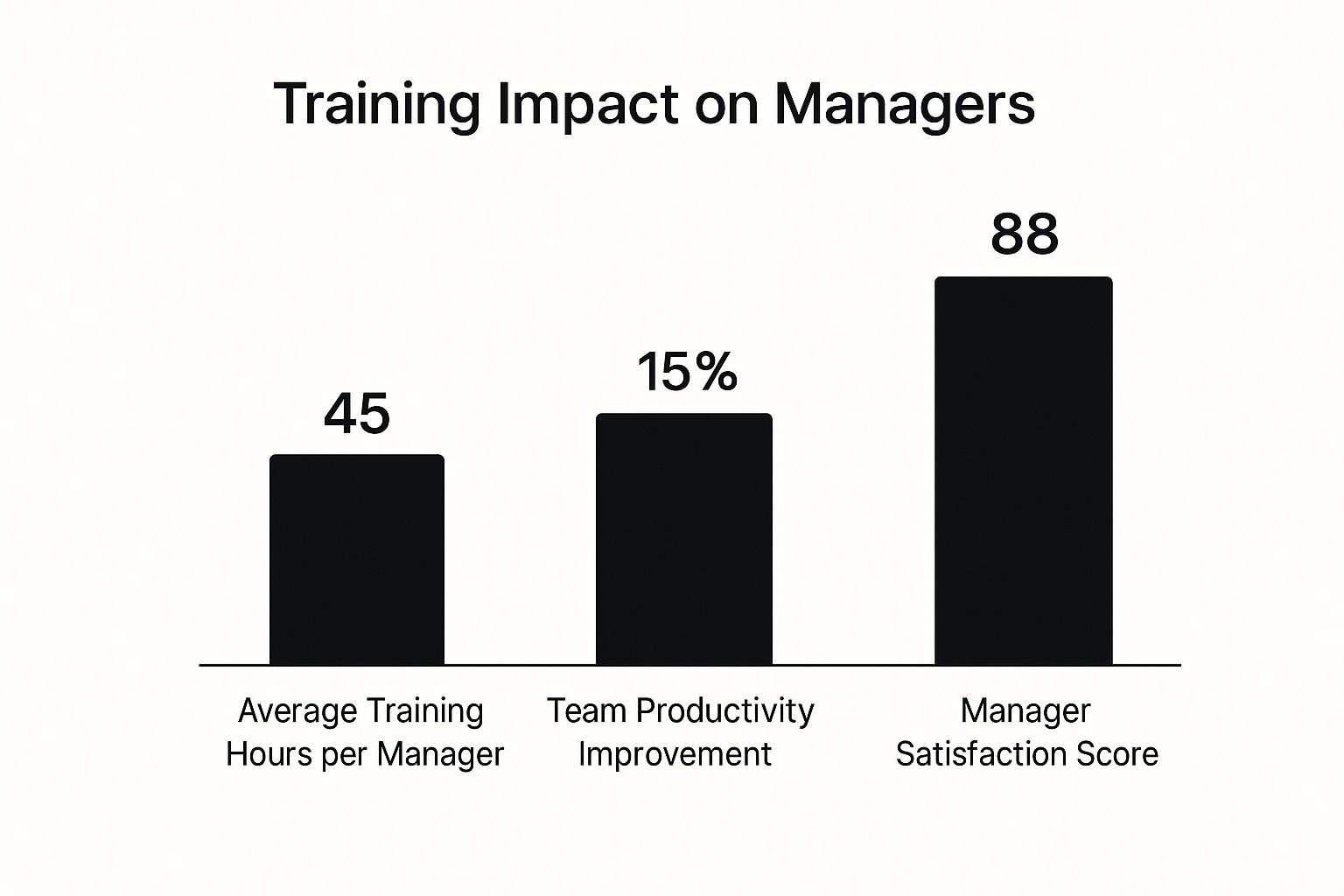Why Performance Manager Training Has Become Essential
The modern workplace is evolving, and with it, the demands placed on managers. Organizations are realizing the crucial need to equip their management teams with new skills to navigate these changes. This shift is driven by the significant costs associated with ineffective management, impacting everything from employee retention to productivity, and ultimately, the bottom line. Disengaged employees, often a symptom of poor management, cost U.S. companies up to $550 billion each year. This highlights the undeniable link between effective performance management and overall business success.
The Shift Toward Continuous Feedback
This need for change is evident in the growing dissatisfaction with traditional performance review systems. Annual reviews are often viewed as insufficient for addressing performance in real-time and nurturing continuous growth. Traditional performance management often lacks the agility to adapt to individual employee needs and diverse work styles, meaning valuable feedback and development opportunities are frequently missed.
Industry research reveals a dramatic transformation in performance management systems, with manager training taking center stage. A 2024 HR.com report indicated that 41% of organizations are moving towards regular one-on-one meetings between managers and employees, a key component of effective performance management. Furthermore, 60% of companies now prioritize frequent or continuous feedback, with 53% investing in manager training to ensure this feedback is both constructive and actionable. A staggering 95% of managers express dissatisfaction with traditional performance review systems, and 90% of HR leaders acknowledge these outdated methods fail to accurately reflect employee contributions. Learn more: Performance Management Statistics. This shift toward more frequent and personalized feedback necessitates performance manager training that empowers managers with the essential skills. For those interested in website development, explore this resource: How to master website building.

The infographic above visually represents the impact of performance manager training, showcasing average training hours per manager, resulting team productivity improvements, and overall manager satisfaction. The data clearly shows a direct correlation between increased training investment and higher team productivity and manager satisfaction, underscoring the tangible returns of effective performance manager training. These improvements extend beyond individual teams, positively influencing overall organizational performance.
To further understand the shift in approaches, let's look at a comparison:
Traditional vs. Modern Performance Management Approaches
Comparison of outdated performance review methods versus modern continuous feedback systems
| Traditional Approach | Modern Approach | Impact on Manager Training |
|---|---|---|
| Annual performance reviews | Continuous feedback | Requires training on providing regular, constructive feedback |
| Focus on past performance | Focus on future development | Necessitates coaching and development skills training |
| One-size-fits-all approach | Personalized feedback | Demands training on adapting to individual needs and learning styles |
| Infrequent feedback | Frequent check-ins and one-on-ones | Emphasizes communication and active listening skills training |
This table highlights the stark differences between traditional and modern performance management, emphasizing the significant role manager training plays in facilitating this essential transition. Modern approaches require managers to develop new skills in providing consistent, individualized feedback and fostering a culture of continuous growth.
Bridging the Gap Between Traditional and Modern Management
Investing in performance manager training is no longer optional—it's a requirement for organizations aiming to flourish in today’s dynamic business landscape. By empowering managers with the necessary skills and knowledge, businesses can cultivate an environment of continuous improvement, unlock the full potential of their employees, and achieve sustainable growth. This necessitates a departure from outdated annual reviews and a move towards a more agile and adaptable approach.
Core Skills Every Performance Manager Needs To Master
Performance manager training is an investment in cultivating leaders who can inspire, motivate, and drive team success. This means developing a specific skill set that empowers managers to truly lead, not just oversee tasks. These skills are the foundation of effective performance management and what sets exceptional managers apart.
Essential Competencies For Today's Performance Managers
Effective performance managers possess a diverse range of skills, allowing them to navigate the complexities of today's workplace. These competencies are key to fostering a culture of continuous improvement and unlocking a team’s full potential.
-
Conducting Effective One-on-Ones: These meetings are more than just status updates. They are valuable opportunities to connect with team members, understand their individual challenges, and provide personalized guidance. Active listening, empathy, and insightful questions are crucial here.
-
Providing Feedback That Motivates: Feedback is a powerful tool for growth when delivered constructively. Performance managers must master the art of providing specific, actionable feedback that encourages development. This involves focusing on behaviors and illustrating points with clear examples.
-
Setting Clear Expectations and Driving Results: This involves establishing clear goals, defining roles and responsibilities, and ensuring team members have the resources they need to succeed. It’s about empowering team members to take ownership and thrive without constant oversight.
-
Navigating Challenging Conversations: Addressing performance issues directly is essential for growth. Skilled performance managers handle difficult conversations with empathy and firmness, always focusing on solutions and fostering mutual understanding.
-
Adapting to Different Personality Types and Work Styles: Every individual has unique needs and preferences. Effective performance managers adapt their communication and management styles to create a supportive and inclusive environment for everyone.
The Impact of Coaching and Behavioral Insights
Effective performance management uses behavioral insights to understand what motivates individuals and drives performance. This means recognizing that different people respond to different approaches. You might be interested in: How to master the GPL.
-
Evidence-Based Coaching Methods: Coaching is about empowering team members to discover solutions and unlock their own potential, not simply giving advice. Proven coaching frameworks facilitate self-discovery and growth.
-
Maintaining Accountability with Support: Accountability doesn't have to be punitive. Skilled performance managers build a culture of accountability that feels supportive, not threatening. This is achieved by setting clear expectations, providing consistent feedback, and offering resources for development.
Companies that invest in leadership and performance manager training see substantial returns. Organizations that offer leadership training experience a 25% boost in business performance and a 20% increase in overall performance on average. Companies that invest in general employee training, including performance manager development, are 17% more productive and 21% more profitable. You can find more detailed statistics here: Employee Training Statistics. These results demonstrate the significant impact of developing effective performance managers. This investment not only improves individual manager effectiveness but also contributes to broader organizational success.
Building Training Programs That Create Lasting Change

Many performance manager training programs miss the mark. Why? They often prioritize theory over practical application. This disconnect between learning and doing leads to minimal impact on actual management behaviors. This section explores what makes successful performance manager training truly effective. We'll delve into the methodologies that inspire lasting change, transforming managers into powerful leaders.
Designing Curricula That Address Real Workplace Challenges
Effective performance manager training starts with identifying existing skill gaps. This requires understanding the daily challenges managers encounter. The training curriculum should then directly address these challenges, providing practical solutions and applicable skills.
For example, if managers struggle with giving constructive feedback, the training should offer concrete techniques and practice opportunities. Addressing real-world problems ensures the training is relevant and immediately useful.
Additionally, incorporating real workplace scenarios is vital. Role-playing exercises, case studies, and simulations bridge the gap between theory and practice. This immersive learning allows managers to apply new skills in a safe environment, building confidence for real-world application.
Creating Practice Opportunities and Ongoing Support
Practice is key for skill development. Training programs should offer ample opportunities for managers to use what they’ve learned. This could include peer coaching sessions where managers practice new techniques with colleagues and receive feedback.
These interactive sessions create a safe and supportive space to refine skills and build confidence. Regular practice helps solidify learning and translate it into improved on-the-job performance.
However, training shouldn’t be a one-time event. Lasting change requires ongoing support and reinforcement. Peer coaching models, mentorship programs, and regular follow-up sessions offer continued guidance. This prevents managers from reverting to old habits and helps them integrate new skills into their daily routines.
Leveraging Technology and Human Connection
Technology enhances performance manager training. Online platforms, microlearning modules, and virtual simulations offer flexible and accessible learning experiences. This empowers managers to learn at their own pace and revisit materials whenever needed.
Technology also facilitates communication and collaboration. Online forums and discussion groups connect managers across departments. This fosters a sense of community and provides a platform for sharing best practices and addressing shared challenges.
Ultimately, the most effective training blends technology with human connection. Technology provides accessibility and flexibility, while mentorship, coaching, and peer interaction create a truly supportive environment. This powerful combination fosters a culture of growth that extends far beyond the training program itself.
Measuring What Matters In Training Effectiveness

Truly grasping the impact of performance manager training means going beyond simple satisfaction surveys. It requires carefully chosen metrics that reflect real improvements in key management skills. This section offers frameworks for tracking training effectiveness and demonstrating a tangible return on investment.
Establishing Meaningful Baselines and Key Indicators
Before training begins, establish a performance baseline. This means identifying Key Performance Indicators (KPIs) that align with the training goals. For example, if the goal is better communication, measure pre-training communication effectiveness through surveys or observation. This baseline becomes the benchmark for measuring post-training improvements.
This lets you see the training's direct impact on specific management behaviors. Also, identify indicators that predict long-term success. These could be employee engagement, retention rates, or team performance metrics.
Tracking these indicators reveals the training's lasting impact and highlights areas for ongoing development. This long-term view strengthens the case for continued investment in manager development. Performance manager training is a crucial investment, and the financial stakes are high. The global leadership development market, including performance management training, was valued at $366 billion in 2025. $166 billion of that was spent in the US alone.
Companies that neglect this training can see profits drop by up to 7%, while those actively investing see 24% higher profitability. For a deeper dive into these figures, check out these Employee Training Statistics.
Utilizing Quantitative and Qualitative Data
Measuring training effectiveness demands both quantitative and qualitative data. Quantitative measures, like retention rates, productivity scores, project completion rates, and employee engagement survey data, provide concrete numbers.
Qualitative data offers deeper insights into how behaviors change. These indicators, like improved communication, increased team collaboration, and better conflict resolution, are often gathered through observation, feedback, and interviews.
Combining both data types creates a comprehensive picture of training impact. This holistic approach paints a compelling picture of how training leads to real-world improvements.
To help you visualize the potential ROI of your performance management training program, consider the following metrics:
To help you visualize the potential ROI of your performance management training program, let's look at some key metrics. The table below outlines various categories, measurement methods, expected timelines, and industry benchmarks.
Performance Manager Training ROI Metrics
| Metric Category | Measurement Method | Expected Timeline | Industry Benchmark |
|---|---|---|---|
| Employee Retention Rate | Track the percentage of employees who remain with the company after the training. | 6-12 months | Increase of 5-10% |
| Employee Engagement Scores | Use surveys to measure employee satisfaction and motivation. | 3-6 months | Increase of 10-15% |
| Team Performance Metrics | Track metrics like project completion rates and productivity. | 6-12 months | Increase of 15-20% |
| Manager Effectiveness Ratings | Gather feedback from team members to assess manager performance. | 3-6 months | Improvement of 10-15% |
By tracking these metrics, you can gain a clear understanding of the impact your training program is having and identify areas for improvement.
Demonstrating ROI and Building a Business Case
Calculating the Return on Investment (ROI) is crucial for securing continued support. This means connecting improved performance directly to profits. Demonstrating increased productivity, fewer errors, or improved customer satisfaction showcases the value of training.
Ongoing Assessment and Course Correction
Evaluating training effectiveness is an ongoing process. Regular follow-up surveys, performance reviews, and feedback sessions are essential for gauging the training's sustained impact. This allows for necessary course correction and ensures the program continues to deliver results.
Overcoming Resistance And Implementation Roadblocks

Even the most thoughtfully crafted performance manager training programs can hit unexpected bumps in the road. These obstacles can range from hesitant managers to tight deadlines and diverse skill sets within the group. This section explores these common implementation hurdles and offers practical, actionable solutions, inspired by the successes of HR leaders who've already cleared these hurdles.
Gaining Buy-In and Addressing Skepticism
One frequent challenge is pushback from managers who see training as time taken away from "real work." To overcome this, clearly articulate the value of performance manager training, highlighting its positive impact on team productivity and the company's overall objectives. Present training not as a chore, but as an investment in their leadership growth.
For instance, demonstrate how the training can equip managers with stronger communication skills, the ability to delegate more effectively, and enhanced conflict resolution skills. These all lead to increased productivity and a more positive work environment. Involving managers in the training design process itself also fosters a sense of ownership and ensures the content aligns with their specific needs. You might also find this interesting: How to master PNG Optimization.
Handling Varying Skill Levels and Creating Safe Environments
Another hurdle is managing the diverse skill levels within training groups. Some managers may already be seasoned leaders, while others are just beginning their leadership journey. To cater to these differences, consider a blended learning approach that combines foundational and advanced modules.
This allows managers to focus on areas where they personally need the most growth. Equally important is creating a safe space for practicing new skills. Encourage peer feedback, role-playing, and open discussions within the group. This supportive atmosphere empowers managers to experiment without fear of judgment, building confidence and encouraging growth.
Maintaining Momentum and Ensuring Consistent Application
Sustaining momentum after the initial training is essential for long-term success. Offer ongoing support through initiatives like mentorship programs, peer coaching sessions, and refresher courses. These reinforcements help solidify learning and prevent managers from falling back into old habits.
Addressing potential resistance to change is also vital. Clearly communicate the advantages of new performance management practices and involve managers in the implementation process. This collaborative approach promotes buy-in and minimizes resistance.
Consistency is key. Ensure consistent application of these practices across all departments and management styles. Customize training materials and examples to address the specific challenges and work styles of each team. This personalized approach amplifies the relevance and impact of the training. By proactively addressing these common implementation challenges, organizations can unlock the full potential of their performance manager training programs, cultivating meaningful and sustainable improvements in management behaviors.
Creating Long-Term Performance Excellence Culture
True performance management excellence isn't a fleeting achievement. It's about cultivating a thriving environment where effective practices are woven into the very essence of your organization. This means building robust support systems, fostering collaborative peer learning, and embracing a mindset of continuous improvement. Let's explore how to embed these vital elements into your company’s DNA.
Building Support Systems and Peer Learning Networks
Many thriving organizations utilize mentorship programs. Pairing seasoned managers with those still honing their skills creates a powerful dynamic. Newer managers gain personalized guidance and support, learning from experienced professionals who’ve successfully navigated similar challenges.
Establishing peer learning networks is another key strategy. These networks offer invaluable opportunities for managers to connect, share insights, and learn from one another’s experiences. They foster a collaborative atmosphere where challenges are openly discussed, solutions are brainstormed, and skills are refined together. This collaborative approach magnifies the impact of training, creating a continuous learning loop. For further insights, you might find this helpful: Read also: How to master the MIT license.
Providing regular practice opportunities is also essential. Simulated scenarios, case studies, or peer feedback sessions create a safe space for managers to apply new skills and receive constructive feedback. This builds confidence and competence, reinforcing learning and helping managers translate training concepts into real-world application.
Continuous Improvement and Aligning with Company Values
Cultivating a culture of continuous improvement hinges on regular feedback. These feedback mechanisms, such as self-assessments, peer reviews, or team member feedback, empower managers to continuously refine their skills and adapt to evolving business needs. This ongoing feedback loop cultivates a growth mindset and ensures performance management practices stay aligned with company objectives.
Aligning these practices with broader company values is paramount for long-term success. This provides trained managers with the organizational support and resources they need to flourish. It also reinforces the message that performance management isn't just a task to be checked off, but a core component of the company’s culture.
From Short-Term Compliance to Long-Term Success
The true purpose of performance manager training transcends mere compliance. It's about profoundly impacting how managers lead and develop their teams. By integrating ongoing support systems, fostering peer learning, and embracing continuous improvement, organizations can cultivate a culture of performance excellence that fuels sustainable growth. This approach elevates performance management from a periodic activity to an ingrained element of the organization's operational fabric. It's about moving beyond checking boxes and fostering a culture where continuous improvement is the norm. This shift benefits not only individual managers and their teams, but the entire organization as a whole.
Your Implementation Roadmap
Transforming your organization's performance management requires a structured approach. This roadmap provides a practical, step-by-step guide to implementing effective performance manager training. It's a journey that begins with an honest assessment of your current management capabilities and culminates in a culture of continuous improvement.
Assessing Current Management Capabilities and Prioritizing Needs
First, take an honest look at your current management capabilities. Identify existing skill gaps and areas where training can make the biggest difference. This assessment should involve surveys, interviews, and observation of current management practices. For dynamic animation inspiration, check out Web Animations.
Next, prioritize training needs based on their impact on your business. Focus on areas that align with your organization's strategic objectives. For example, if improving customer satisfaction is a key goal, prioritize training that enhances communication and customer service skills. This strategic approach ensures your training resources are invested wisely.
Securing Buy-In and Creating Realistic Timelines
Gaining buy-in across your organization is crucial for successful implementation. Clearly communicate the benefits of performance manager training to leadership, emphasizing its potential return on investment. Make a strong case demonstrating how training can improve key performance indicators (KPIs) and contribute to overall organizational success.
Developing realistic timelines is also essential. Consider existing workloads, budget constraints, and the availability of training resources. A phased implementation allows for manageable progress and minimizes disruption to daily operations. This practical approach acknowledges limitations and builds in flexibility.
Allocating Resources and Establishing Success Metrics
Allocate appropriate resources without overspending. This involves budgeting for training programs and allocating time for managers to participate and apply their new skills. Resource allocation demonstrates your organization’s commitment to performance management.
Establishing clear success metrics is essential for gauging the training's effectiveness. These metrics should align with the initial needs assessment and reflect the specific skills being developed. This allows for accurate measurement of training impact and informs future training initiatives.
Implementing Your Performance Management Training Program
Here's a checklist to guide your action plan:
- Assessment: Conduct a thorough needs assessment to pinpoint skill gaps and prioritize training needs.
- Buy-in: Secure leadership support and communicate the value of training to managers.
- Timeline: Develop a realistic implementation timeline that accounts for existing workloads and resources.
- Budget: Allocate appropriate resources within your budget.
- Metrics: Establish clear success metrics to measure training effectiveness.
- Evaluation: Implement ongoing evaluation to track progress and make any necessary adjustments.
Here's a table outlining implementation milestones:
| Milestone | Action Items | Timeline |
|---|---|---|
| Phase 1: Preparation | Needs assessment, secure buy-in, develop timeline | Within the first month |
| Phase 2: Rollout | Launch training programs, allocate resources | Within the next two months |
| Phase 3: Evaluation | Track metrics, gather feedback, adjust program | Ongoing, quarterly reviews |
By following this roadmap, you can effectively implement performance manager training and foster a culture of continuous improvement. This structured approach empowers managers with the skills they need to lead, inspire, and drive success.
Ready to transform your organization's performance management? Learn how the Global Human Resource Institute can help your team thrive. Visit the Global Human Resource Institute to explore their HR certifications and training programs designed to elevate your performance management strategies.




0 Comments